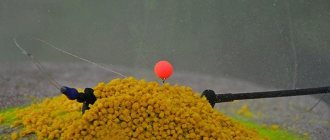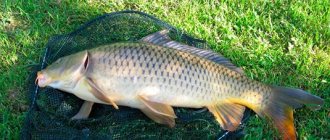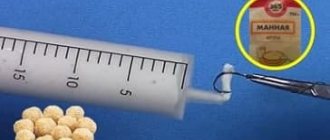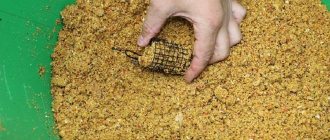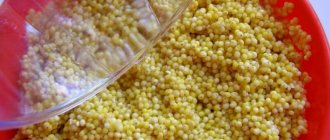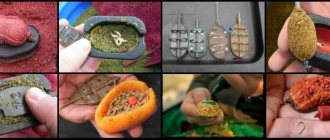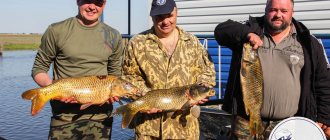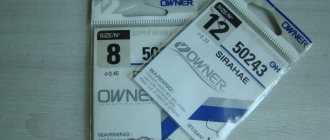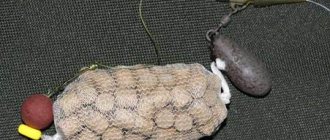There are many ways to catch fish, but the most popular, and most importantly effective, is bottom fishing with a feeder. It was this element of equipment that greatly increased the effectiveness of the primitive donkey that was in service with our fathers and grandfathers. In general, the design is not complicated at all: a feeder with aromatic filling and a leash with a hook on which a delicious worm or maggot spins. The fish approaches the smell of food and swallows the bait. Nothing could be simpler!
Analogues of such gear are found in fishing literature from the middle of the last century, however, it is considered relatively new, and its development is attributed to the British. They set the tone in this type of fishing, constantly developing and improving it. One of the latest original finds of fishermen from Foggy Albion was the flat method - a flat feeder rig with an open feeder, working on the principle of a nipple that has long been known to us. The only difference is the length of the leashes and the number of hooks. And also in the incredible catchability of the new product. The high efficiency of the flat feeder method has given rise to rumors that it was allegedly banned in the West, but this is more of a fishing tale. Let's try to figure out whether it really catches, what it catches and how.
Flat feeder method
The flat-method open feeder was invented after many years of observing underwater inhabitants, in particular after a detailed study of their feeding habits. Today, even a novice fisherman knows that domesticated and wild carp (carp), bream and some of their close relatives consume food by suction. If you lower the underwater camera from the boat and watch the actions of the same bream, you can see how it sucks in everything with its “telescopic” mouth, like a vacuum cleaner, filters and spits out inedible particles. The same thing happens with a flat-method feeder: the fish sucks the food washed out around it until there is a hook in its mouth.
In the classic version, the method type feeder consists of a frame (grid) and a lead weighting agent. Weight varies from 30 to 80 g, which is quite enough for fishing in rivers with moderate currents. Usually, casting a feeder with such a mass does not require a powerful rod, but this is not the case. All elements of the tackle, including the reel and fishing line, must have a certain margin of safety, since this method is used to catch mainly large and strong fish.
The vast majority of feeders of this type are made of plastic, although recently lightweight metal products have also begun to be common. Their upper part is open; there are several characteristic protrusions on it for binding bait.
There are three types of method feeders: for fishing on silted reservoirs, for fishing on a hard bottom, and also for fishing in weak currents or in stagnant ponds and lakes. Models from the first category are distinguished by a shifted center of gravity, due to which they always fall to the bottom surface in the same position. The loaded side is on the bottom, and the groundbait and hook with bait are on top. It's like a tumbler doll. The fisherman need not be afraid of the “burial” of the hook; it always remains on top. At the same time, the flat bottom holds the feeder even on very soft ground and does not allow it to sink into a thick layer of silt.
How to cook complementary foods
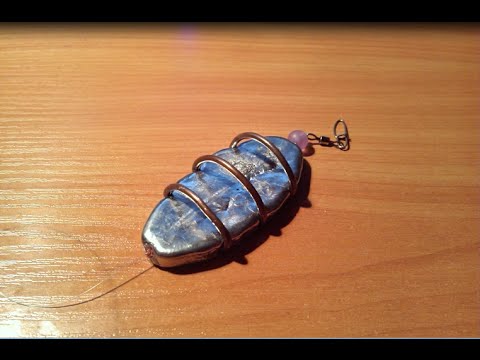
When planning to make bait, you should understand what the entire mixture and its individual components will be intended for. Based on the fishing conditions and the selected gear, the prepared composition may differ radically.
The bait for the method feeder should:
- Lure fish.
- Be moderately sticky and thick, because the food should dissolve within 5-10 minutes.
- You should not make a loose mixture so that it does not crumble ahead of time.
- Don't blow your budget.
- you need 3 grains that will hold the fish in place and lure them - corn, wheat and barley;
- in order to increase the viscosity of the mixture, you need to use glue for bait (the amount of glue depends on the strength of the current in the pond where you will be fishing, 200-550 grams);
- makha (ground) – perfectly attracts prey with the help of the smell that carp, crucian carp and other fish love (1 liter);
- breadcrumbs (holds the mixture together well) - 0.5 kg;
- corn flour (0.7 kg) – a good flavoring and thickener;
- artificial flavors, dog food, pigments and more can be used as additional additives;
- you need to moisten the mixture so that it sticks well;
- it is important that the bait is not plasticine, but is destroyed in the water, leaving the bait on the food spot;
Food in fishing is one of the most important elements, because it ensures the interest of the fish.
Successful fishing in most cases depends on proper feeding of crucian carp. However, her recipes for all occasions simply do not exist, because all bodies of water, as well as the taste preferences of crucian carp, are not at all similar to each other.
The menu of this fish includes worms and various larvae; crucian carp can easily feed on mud or algae. As a result, he is almost constantly full.
Therefore, in order to attract it, it is necessary to use bait. It is needed to lure the crucian carp to the appropriate place and keep it there for a long time.
You can use purchased bait or make it yourself, it depends on the preferences of the fisherman himself.
The best basis for preparing bait for crucian carp are:
- peas;
- cereals;
- compound feed;
- crushed wheat grains;
- corn flour;
- semolina;
- bran;
- breadcrumbs or rye crumbs;
- pearl barley;
- cake;
- millet;
- oatmeal.
In spring or autumn, bait should include ingredients such as bloodworms, maggots, and crushed worms. Sometimes such feeding is in demand in the summer.
In order not to oversaturate the crucian carp, feeding should be done in small quantities. However, it is also necessary to take into account the nature of the reservoir. Bait that is too crushed for crucian carp will be lost in thick algae and will therefore be inaccessible to the fish. Such bait should include a large (50-70%) share of ballast. For this purpose, clay is used in the current, and earth or sand is used in the pond.
Crucian carp loves odorous substances, but you need to add them carefully, literally a couple of drops at a time. In addition, you cannot use many different flavors; such a mixture of smells will scare the fish away from the groundbait and bait. The best bait for crucian carp should exude a subtle aroma.
In addition, he also has his own preferences for scents, depending on the season. For example, vanillin is better in summer, garlic is better in autumn, and in winter it is not recommended to flavor the fertilizer at all. In addition, it must be taken into account that the smell of tobacco and mosquito repellent on the bait will significantly reduce the bite.
Most fishermen prepare their own bait for fishing. Preparing such a mixture is not at all difficult, and almost every angler has his own personal recipe. Well, we, in turn, also offer you proven recipes that will definitely help when fishing.
The main purpose of the “Method” feeder is carp fishing. This device is recommended for use only in standing water. Of course, the feeder is suitable not only for catching carp, but also for fish that feed at the very bottom.
Complementary food for such designs should also have many properties. The bait is significantly different. Here are some basic selection criteria:
- Complementary food should be attractive to fish.
- When casting, the mass should not fall out of the feeder.
- When hitting the surface of the water, the complementary food should not fall apart.
- The bait should gradually disintegrate in the water. This should take about 15 minutes.
Groundbait for “Method” feeders is quite simple to prepare. There are several recipes. Some foods need to be boiled.
You need to mix 2 cups of millet and corn flour. This component should be filled with water. The liquid should completely cover the cereal and be 4 centimeters above its level. Cook the porridge until the water has completely boiled away.
Mix the finished millet with 1 cup of pre-ground seeds. After this you will need hemp seeds. 1 glass will be enough. The component should be boiled. The hemp seeds should swell after cooking. After this, it is recommended to mix them with porridge. If desired, other components can be added to the resulting mass. The main thing is that the mixture retains its stickiness.
Perhaps no species of fish is as revered by feeder followers as bream. Our grandfathers and great-grandfathers also caught bream with primitive donks, and pea porridge was considered the best bait.
Now there are fewer fish, and there are more fishermen, and in order to tempt cautious fish to bite, more and more advanced baits and baits are used. Bait for bream has also passed the test of time, and we will look at what it has become today in this material.
Some fishermen choose mixtures of well-known foreign bait manufacturers, others switch to domestic ones, for example, compositions of the Dunaev brand. A special category of fishermen are homemade fishermen.
They love to do everything with their own hands - from gear to boats. Such fishermen mix their own baits, sometimes with a rather secret composition.
Factory baits
French bait has proven itself quite well in domestic fishing grounds. Its bait mixtures belong to the premium class, and are beyond the means of many fishing enthusiasts. Recently, it has been competing with the Polish “Traper”, mainly due to the lower price of its products.
Traper mixtures came to Russia through neighboring Belarus, whose fishermen had long been eyeing the products of this company. In addition to classic baits, “Traper” produces a wide range of pellets and other baits. The line of “Traper” bait mixtures:
- The “Gold” series is a premium series to satisfy the ambitions of sports fishermen.
- The “Leczsz” series is, as the name suggests, a bream bait.
- “Fider” series - special mixtures for feeder fishing.
- The “Traper” series is the most budget-friendly mixture, also available in large packaging up to three kilograms. Some mixtures are packaged in plastic buckets.
- “Secret” series - multi-colored mixtures for fishing in various conditions. Here you can find light baits for bream, dark ones for roach, and bright ones - yellow and red - for muddy water.
- The “Karpiowate” series is an excellent base mixture for making your own bait.
- “Zimowe” series – for cold water and ice fishing. It is also used in the spring after the ice melts.
- “Zimowe Ready” series - ready-made, mixed bait for winter fishing. Ideal for ice fishing for bream.
- The “Giant” series is large-sized bait for attracting trophy fish. Can be classified as premium.
The habitat of this fish is wide. Bream is found both in rivers and lakes, and in artificial reservoirs.
Despite this, it is quite difficult to catch him. Bream is careful and cunning.
During daylight hours, it prefers to hide in deep creeks or river bends away from the shore. Towards evening it comes out into shallow water.
In order to attract bream to the right place, special bait is needed. The success of fishing depends not only on the correctly selected mixture, but also on its quantity and method of delivery to the place.
Composition of homemade bait for bream
The composition largely depends on the fishing conditions. In the preparation process, it is necessary to take into account the type of reservoir, flow speed, depth, time of year, gear used, etc.
Fishermen are wary of store-bought bait mixtures, especially imported ones. It is preferable for them to prepare the bait themselves, using certain flavorings and ready-made feed mixtures in the required proportions during the preparation process.

The ingredients used are:
- corn and wheat breadcrumbs;
- roasted and crushed olive seeds (sunflower, rapeseed);
- powdered milk;
- rolled oats, pearl barley, bran, millet, peas;
- sunflower cake;
- eggs, bread crumb and milk are used to give the mixture viscosity;
- bloodworms and chopped worms (in winter);
- various aromatic additives - depending on the time of year and weather conditions.
Hemp seeds or cake are used as components, but practice shows that in many reservoirs this smell only scares bream and attracts smaller fish. So you need to use hemp ingredients carefully.
One of the main conditions that the finished product must meet is to attract fish and keep them in the right place without letting them get enough. For these purposes, components are added to branded bream mixtures that speed up metabolism and stimulate appetite.
For each type of substance, the substances are selected individually and kept secret by the companies. Crushed, fried pumpkin seeds are used as an appetite-enhancing ingredient for bream when creating homemade food.
The specific set of ingredients and the amount of food required for fishing are determined directly on the reservoir. The components are prepared at home and mixed directly on the pond.
The main thing is that all the components of the mixture are well crushed and do not allow the fish to quickly get enough.
Blind and sliding installations
Blind rigging is a self-cutting installation option that is used when underwater inhabitants are highly active. A fish that has swallowed the bait senses a catch, tries to free itself and is caught due to the resistance of a heavy feeder (60, 70 or 80 g). For the base, durable monofilament fishing line with a diameter of up to 0.4 mm is usually used. You need to thread it into the tube of the feeder, tie a swivel at the end and pull it so that it fits rigidly into the tube halfway. In this case, the second eye of the swivel remains outside and a leash with a hook is attached to it. The optimal leash length is 8-10 cm. To connect to the main line, a loop is made at the second end, at a distance of about 40 cm from the feeder.
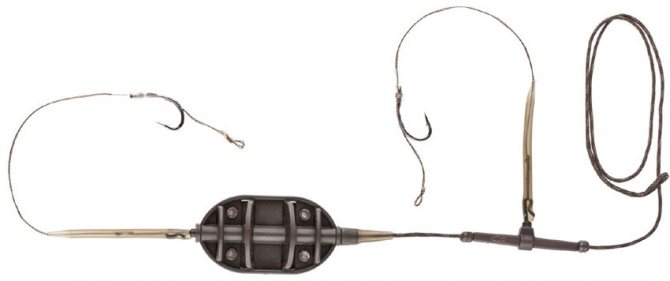
Instead of monofilament, sports fishermen often use a special braid with a lead core. This cord is called leadcore. It has several advantages, namely:
- the equipment never gets twisted;
- the base sinks into the mud and becomes invisible;
- The design on the leadcore scares the fish less and does not injure it during fishing.
Leashes for flat-feeder
In method fishing, the length of the leash and the material from which it is made are of great importance. As a rule, in such fishing, very short leashes are used, no longer than 10 cm, but in the sliding installation option their length can be increased if necessary. Most often this is needed in those moments when the fish “breaks records” for caution.
For making leashes, leader material or fluorocarbon monofilament, invisible in water, is suitable. You can use a regular one, but there is a risk that this will negatively affect the quantity and quality of bites.
Classic flat-method fishing involves the use of carp hairline. Fans of carp fishing do this, and other fishermen put the bait directly on the hook and catch large fish with almost the same success.
Carp fishing method
When fishing for carp using the “Method”, the correct selection of bait, finding a good place and a lot of patience play an important role. Having cast the tackle, it is very advisable not to touch the rod at all until the bite, so as not to create vibrations that are transmitted along the fishing line and scare away large fish.
When choosing a casting location, pay attention to the level of activity of the fish in different areas. Throw it where the presence of a large variety of fish is clearly visible. The frequency of recharging the feeder also depends on the degree of activity of the fish.
Large carp pays attention to the smell, the color, and the very content of the bait, so the latter should have a natural color and be very nutritious. You can use corn, worms, boilies and other baits as bait. Using dips when fishing using the method will also not be superfluous.
Recommendations for choosing a feeder
Flat models with lead weights at the bottom and angular protrusions at the top, designed to securely hold the feed, have proven themselves to be excellent.
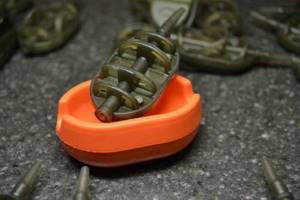
The design is balanced in such a way that no matter how you cast it, it will still sink to the bottom with the loaded side, and the hooks and bait will remain on top and will be accessible to underwater inhabitants.
The choice of feeder must be approached responsibly and carefully, because some models are designed exclusively for solid installation. To avoid problems with fixing the bait, it is advisable to choose branded products that include a mold. Today, the most popular products are from such advanced fishing companies as Gardner, Preston, Korum, Vegas, Avid Carp.
Flat feeders. Theory
The appearance of flat-method equipment was due to the experience of fishing with the classic feeder method, which uses triangular feeders with one or two loaded ribs. One of the main conditions for effective fishing using the classical method is the correct placement of the hook with the nozzle, which is pressed into the bait. After washing away the sticky mixture pressed into the feeder, the hook is released and takes a working position in which the floating bait will be clearly visible to the fish. Therefore, the hook is placed on the side opposite the loaded part of the feeder, so that after it gets into the water and the bait is washed away, it ends up at the top.
Unfortunately, often when fishing using the classic method, the hook with the nozzle ends up under the feeder. This greatly reduces the chances that after the bait is washed away, the bait will be accessible to the fish. This is where the idea arose to make an open feeder with a flat, loaded bottom, which would ensure the correct position of the hook at the bottom of the reservoir. This means it will increase the chances of catching fish.
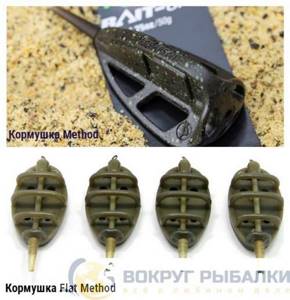
Now it is difficult to say which company was the first to release flat feeders (flat). A worthy product was presented by the Preston company, which now occupies a leading position in the market of flat feeder products. The flat feeder differs from other method feeders in that it has a flat, loaded bottom. Due to this, it smoothly descends in the water column and the bait into which the hook is trampled always ends up at the top. That is, with the help of these feeders, the problem associated with the possibility of a hook with a nozzle getting under a standard feeder was solved.

The first models of flats had a light weight, 15-30 grams, and were used for short-range fishing in English reservoirs of the classic type, which were small in size and had a significant number of fish. Such reservoirs are widespread not only in the UK, but also in other European countries. It is not surprising that the new fishing method gradually attracted the attention of many fishermen in the Old World. When we became interested in it, it turned out that we would have to modify the flat installation method, since we don’t have many small and densely stocked reservoirs. Large expanses of artificial and natural standing reservoirs required long casting, which is impossible with light feeders. And I wanted to catch bigger fish, but it’s difficult to do this with delicate equipment, hooks and lines, even if it’s possible in principle. After the necessary modifications, including making the feeders heavier, the flat equipment acquired a lot of advantages, which we wanted to talk about in this article.
Groundbait for flat feeder
The bait mixture for flat method fishing should have a slightly higher density and viscosity than for fishing with other feeder feeders. It is important to achieve such a consistency that it does not disintegrate when it hits the water, sinks safely to the bottom, and then gradually falls apart into lumps, creating a compact bait spot at the point.
The ideal bait releases the feeder within 10-15 minutes. The desired viscosity is achieved through proper wetting.
Water should be added little by little and as needed. If there is not enough of it, the mixture will turn out to be too loose, and if it is over-moistened, it will become like clay and will lie in one big lump for a long time, without attracting fish. Since such bait is invisible from a long distance, it does not create either a bait column or a large feeding spot, the bet should be on flavors. With an open type feeder, it is most convenient to use flavoring sprays.

